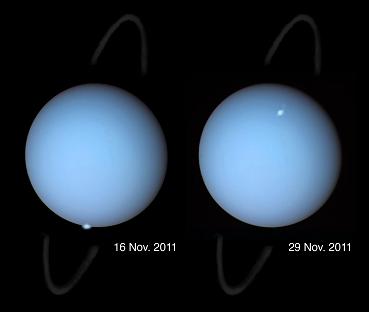WASHINGTON—For the first time, scientists have captured images of auroras above the giant ice planet Uranus, finding further evidence of just how peculiar a world that distant planet is. Detected by means of carefully scheduled observations from the Hubble Space Telescope, the newly witnessed Uranian light show consisted of short-lived, faint, glowing dots – a world of difference from the colorful curtains of light that often ring Earth's poles.
In the new observations, which are the first to glimpse the Uranian aurora with an Earth-based telescope, the researchers detected the luminous spots twice on the dayside of Uranus – the side that’s visible from Hubble. Previously, the distant aurora had only been measured using instruments on a passing spacecraft. Unlike auroras on Earth, which can turn the sky greens and purples for hours, the newly detected auroras on Uranus appeared to only last a couple minutes.
In general, auroras are a feature of the magnetosphere, the area surrounding a planet that is controlled by its magnetic field and shaped by the solar wind, a steady flow of charged particles emanating from the sun. Auroras are produced in the atmosphere as charged solar wind particles accelerate in the magnetosphere and are guided by the magnetic field close to the magnetic poles – that’s why the Earthly auroras are found around high latitudes.
But contrary to the Earth – or even Jupiter and Saturn – “the magnetosphere of Uranus is very poorly known,” said Laurent Lamy, with the Observatoire de Paris in Meudon, France, who led the new research.
.jpg)
Image: Laurent Lamy
Source: aas.org

The aim of art is to represent not the outward appearance of things, but their inward significance. – Aristotle
















